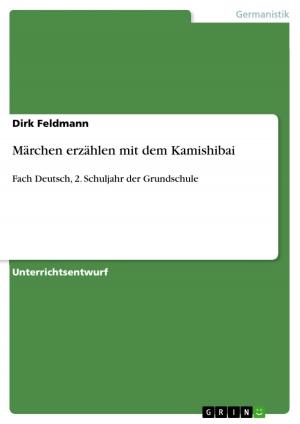Fascination of Movement. Military Parades and Tattoos
The Party Rallies of the Nazi-Regime in Nuremberg
Nonfiction, Social & Cultural Studies, Social Science, Anthropology| Author: | Heide Marie Herstad | ISBN: | 9783668011007 |
| Publisher: | GRIN Verlag | Publication: | July 3, 2015 |
| Imprint: | GRIN Verlag | Language: | English |
| Author: | Heide Marie Herstad |
| ISBN: | 9783668011007 |
| Publisher: | GRIN Verlag |
| Publication: | July 3, 2015 |
| Imprint: | GRIN Verlag |
| Language: | English |
Scientific Essay from the year 2015 in the subject Cultural Studies - Empiric Cultural Studies, Free University of Berlin (ICD), course: e-learning courses, language: English, abstract: The Party Rallies of the NSDAP had such a tremendous impact on the audience and spectators, that the Allied Forces after World War Second used of all places Nuremberg to execute the heads of the Nazi-regime. The Party Rallies of Nuremberg made such a powerful impression that today, the name of Nuremberg has become a symbol for a trial of crime against humanity. There is no doubt, the Party Rallies of Nuremberg were the most powerful nation branding ever. What made these Party Rallies so powerful and unforgettable that we even today can get under its spell? I interpret the fascination of the Party Rallies in Nuremberg as a fascination of movement of military parades and Tattoos. My main question is - what impact have structured and rhythmically arranged movement formations on the audience? Fundamentally, this is a philosophically question. We do not perceive the world out of our free will. The world is physiological and materially structured. These structures have an impact on us. How we regard and perceive the world is dependent on the structures of what we perceive. For example, rhythmically structures have a different impact on us than visual structures. The one can intensify and amplify the other. That happened in Nuremberg. At the Party Rallies at Nuremberg, the rhythmical structure was the music of marches. The function of marches is to regulate and unite the marching of troops and the movement of great mass formations. A perfect unified movement is a marching machine. All human actions are instinctively driven into a rhythmically participation. The underlying rhythmical pattern of marches was at Nuremberg a uniting force. The coordinated and nearly supernatural conducted movement of hundred thousand of people had a tremendous impact on the audience. Seeing these masses moving in rhythmically regular drum beats with a sudden silence in between is even today a hypnotically experience. Why? A military parade and a Tattoo is a choreographically arranged show. I interpret a choreographically arranged movement as a dance. However, the main question is not the definition of dance, but the perception of dance. Why are we fascinated of a dance show? Why can a military defilation and Tattoo thrill us? Why can the mass arrangement of a hundred thousand of people carry us away?
An der Freien Universität Berlin habe ich den Magistergrad in Theaterwissenschaft und Germanistik gemacht. An der Technisch-Naturwissenschaftlichen Universität in Trondheim in Norwegen habe ich das Lehrerexamen für den Unterricht am Gymnasium in Deutsch und Französisch gemacht. An der Universität in Jyväskylä in Finnland habe ich den Doktorgrad in Dramapädagogik gemacht. An der Universität in Trondheim (Norwegen), Kopenhagen (Dänemark) und Stockholm (Schweden) habe ich den Magistergrad in Tanzwissenschaft gemacht. Jetzt arbeite ich als freier Schriftsteller. Ich habe als Deutsch- und Französischlehrerin gearbeitet und als Drama-Pädagogin an verschiedenen Hochschulen in Norwegen. Ich wohne seit achtunddreißig Jahren in Norwegen.
Scientific Essay from the year 2015 in the subject Cultural Studies - Empiric Cultural Studies, Free University of Berlin (ICD), course: e-learning courses, language: English, abstract: The Party Rallies of the NSDAP had such a tremendous impact on the audience and spectators, that the Allied Forces after World War Second used of all places Nuremberg to execute the heads of the Nazi-regime. The Party Rallies of Nuremberg made such a powerful impression that today, the name of Nuremberg has become a symbol for a trial of crime against humanity. There is no doubt, the Party Rallies of Nuremberg were the most powerful nation branding ever. What made these Party Rallies so powerful and unforgettable that we even today can get under its spell? I interpret the fascination of the Party Rallies in Nuremberg as a fascination of movement of military parades and Tattoos. My main question is - what impact have structured and rhythmically arranged movement formations on the audience? Fundamentally, this is a philosophically question. We do not perceive the world out of our free will. The world is physiological and materially structured. These structures have an impact on us. How we regard and perceive the world is dependent on the structures of what we perceive. For example, rhythmically structures have a different impact on us than visual structures. The one can intensify and amplify the other. That happened in Nuremberg. At the Party Rallies at Nuremberg, the rhythmical structure was the music of marches. The function of marches is to regulate and unite the marching of troops and the movement of great mass formations. A perfect unified movement is a marching machine. All human actions are instinctively driven into a rhythmically participation. The underlying rhythmical pattern of marches was at Nuremberg a uniting force. The coordinated and nearly supernatural conducted movement of hundred thousand of people had a tremendous impact on the audience. Seeing these masses moving in rhythmically regular drum beats with a sudden silence in between is even today a hypnotically experience. Why? A military parade and a Tattoo is a choreographically arranged show. I interpret a choreographically arranged movement as a dance. However, the main question is not the definition of dance, but the perception of dance. Why are we fascinated of a dance show? Why can a military defilation and Tattoo thrill us? Why can the mass arrangement of a hundred thousand of people carry us away?
An der Freien Universität Berlin habe ich den Magistergrad in Theaterwissenschaft und Germanistik gemacht. An der Technisch-Naturwissenschaftlichen Universität in Trondheim in Norwegen habe ich das Lehrerexamen für den Unterricht am Gymnasium in Deutsch und Französisch gemacht. An der Universität in Jyväskylä in Finnland habe ich den Doktorgrad in Dramapädagogik gemacht. An der Universität in Trondheim (Norwegen), Kopenhagen (Dänemark) und Stockholm (Schweden) habe ich den Magistergrad in Tanzwissenschaft gemacht. Jetzt arbeite ich als freier Schriftsteller. Ich habe als Deutsch- und Französischlehrerin gearbeitet und als Drama-Pädagogin an verschiedenen Hochschulen in Norwegen. Ich wohne seit achtunddreißig Jahren in Norwegen.















